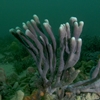General Description
A sandy-green to pink sponge species, flabelliform to branching. Size of about 50 cm.
Biology
Despite the amount of sand and debris incorporated into the skeleton of these sponges, they retain an elastic texture due to the fibre content. Since their skeletons do not contain spicules, they gain structural strength from the sand and other foreign particles incorporated into the sponge.
Habitat
Reef areas, to depth of 30 m.
Sponge gardens
Reefs
Distribution guide
Port Phillip in Victoria.
Species Group
Depth
Water Column
Max Size
50 cm
Diet
Plankton or particles
Commercial Species
No
Global Dispersal
Recorded in Australia
Species Code
sp. MoV 6714
Identify
Conservation Status
- DSE Advisory List : Not listed
- EPBC Act 1999 : Not listed
- IUCN Red List : Not listed





